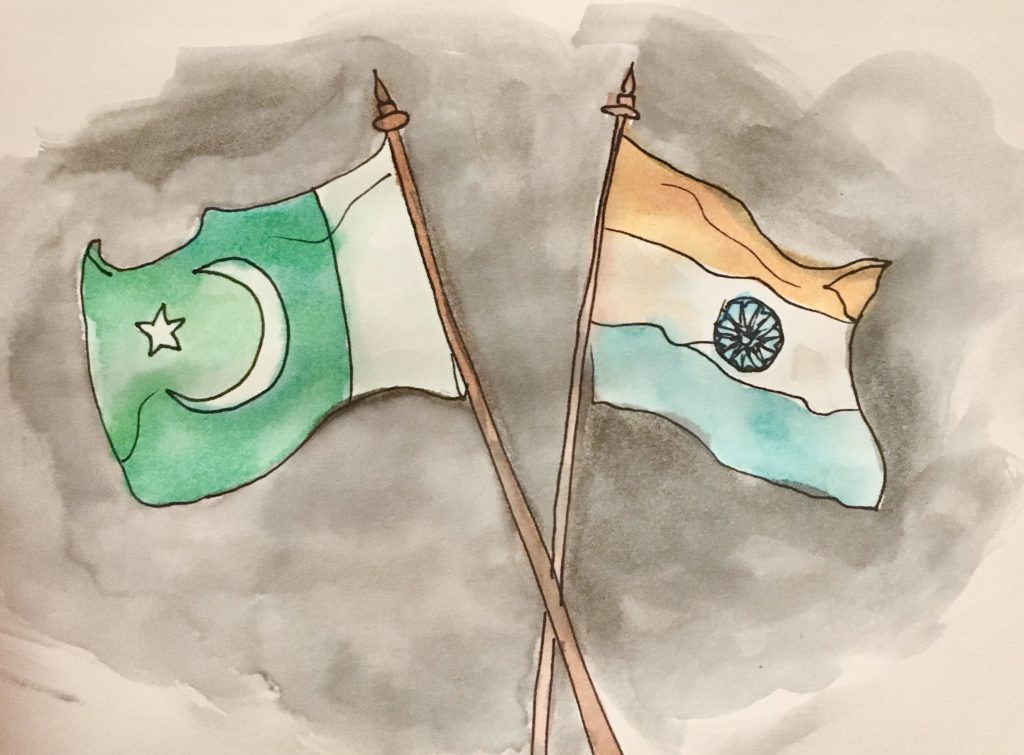By Theresa Aronson ’20
On Nov. 5, CMC’s International Political Journalism class hosted Blake Woods, a former physicist and nuclear weapons designer at Los Alamos National Laboratory, as a guest speaker for its international conflicts unit covering nuclear weapons.
According to Woods, a recent series of military clashes along India and Pakistan’s border last week is raising serious concern.
On Oct. 29, a cross-border exchange occurred along what is known as the Line of Control (LoC), a highly militarized frontier where the two countries frequently exchange arms and other artillery. India and Pakistan blame one another for the cross-border shelling in the Kashmir region that killed and injured soldiers and civilians— including women and children — on both sides.
The foreign affairs ministry reported that six military personnel were killed and several others were seriously hurt in areas near the LoC. News channel Al Jazeera described this as one of the deadliest days since India revoked Kashmir’s special status in August.
Indian defence spokesman Colonel Rajesh Kalia characterized this incident as an unprovoked ceasefire violation by Pakistan.
“Our troops retaliated strongly, causing heavy damage and casualties to the enemy,” Kalia said to a New Delhi reporter with Al Jazeera. According to Kalia, his troops used larger-round artillery fire to hit “terrorist camps.”
Pakistan has rejected India’s accusation that they antagonized the matter, maintaining that India’s attack in Jura, Shahkot and Nowshera sectors on Nov. 7 were indiscriminate and unprovoked, as they deliberately targeted civilians. Major General Asif Ghafoor, a spokesman for the Pakistani Armed Forces, told the Al Jazeera reporter that they responded “effectively” in killing nine Indian soldiers and destroying two bunkers.
With continued violence in the Kashmir region and a surge of activity by Pakistani-based militant groups and the Indian Army, concerns over a military confrontation between the two nuclear-armed neighbors remain ominous.
India currently has in its possession a nuclear triad, and claims to be developing thermonuclear weapons under the ‘Cold Start’ initiative, according to Dr. Woods. Indian Army’s ‘Cold Start’ doctrine is a military defensive doctrine that allows India to undertake limited retaliatory attacks on its neighbor without crossing Pakistan’s nuclear threshold. Similarly, Dr. Woods sees Pakistan’s development of “short-range, forward based, battlefield nuclear weapons,” as a defense against the Indian Army’s Cold Start doctrine. Cold Start is a doctrine geared toward swift offensive operations designed to seize Pakistan without, in theory, risking a nuclear conflict.
“Even though the United States and Russia hold the vast majority of the world’s nuclear weapons, countries with smaller nuclear arsenals, such as India and Pakistan, that are actively engaged in regional conflicts, are considered to be ‘nuclear hotspots,’ because of the high risk for a nuclear conflict breaking out over the ongoing war in Kashmir,” said Woods when asked which countries currently hold the greatest nuclear threat.
Pakistani Prime Minister Imran Khan addressed media at the 42nd session of the UN Human Rights Council (UNHRC) last week, accusing India of human rights atrocities in Kashmir and asking for international intervention to help de-escalate the conflict between the two nuclear nations.
While speaking Al Jazeera, Khan said there is a possibility for a war with India that could “go beyond the subcontinent.
“That’s why we have approached the United Nations, we are approaching every international forum, that they must act right now,” Khan said. He also said that he “absolutely” believes war with India could be possible.
“If the world does nothing to stop the Indian assault on Kashmir and its people, there will be consequences for the whole world as two nuclear-armed states get ever closer to a direct military confrontation,” Khan told the news channel.
Khan’s comment comes after India’s defense minister issued a not-so-covert nuclear threat to Pakistan, saying that the future of India’s “first use” policy of nuclear weapons “depends on circumstance.”
Indian officials still have not indicated when they plan to lift the security restrictions or release the thousands of people who have been jailed. Until such time, negotiations concerning Kashmir have been tabled. For Khan has said the dialogue concerning Kashmir can only start when India reverses its illegal annexation of Kashmir, ends the curfew and lockdown, and withdraws its troops to the barracks.
In his open-letter published in the New York Times, Khan writes: “When two nuclear armed countries fight, if they fight a conventional war, there is every possibility that it is going to end up into nuclear war.”



